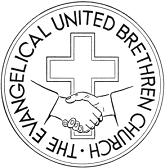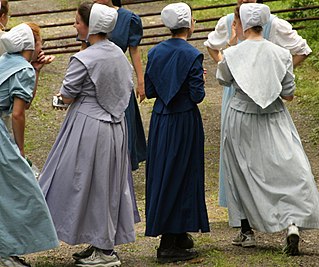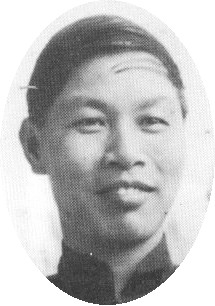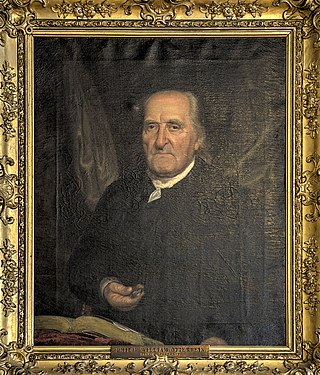
The Evangelical United Brethren Church (EUB) was a North American Protestant denomination from 1946 to 1968 with Arminian theology, roots in the Mennonite and German Reformed, and communities, and close ties to Methodism. It was formed by the merger of the Evangelical Church and the Church of the United Brethren in Christ. The United Brethren and the Evangelical Association had considered merging off and on since the early 19th century because of their common emphasis on holiness and evangelism and their common German heritage. In 1968, the United States section of the EUB merged with the Methodist Church to form the United Methodist Church, while the Canadian section joined the United Church of Canada.

The Schwarzenau Brethren, the German Baptist Brethren, Dunkers, Dunkards, Tunkers, or sometimes simply called the German Baptists, are an Anabaptist group that dissented from Roman Catholic, Lutheran and Reformed European state churches during the 17th and 18th centuries. German Baptist Brethren emerged in some German-speaking states in western and southwestern parts of the Holy Roman Empire as a result of the Radical Pietist revival movement of the late 17th and early 18th centuries.

The Missionary Church is an evangelical Christian denomination of Anabaptist origins with Wesleyan and Pietist influences.

The Old Order River Brethren are a River Brethren denomination of Anabaptist Christianity with roots in the Radical Pietist movement. As their name indicates, they are Old Order Anabaptists.
The Church of the United Brethren in Christ is an evangelical Christian denomination with churches in 17 countries. It is Protestant, with an episcopal structure and Arminian theology, with roots in the Mennonite and German Reformed communities of 18th-century Pennsylvania, as well as close ties to Methodism. It was organized in 1800 by Martin Boehm and Philip William Otterbein and is the first American denomination that was not transplanted from Europe. It emerged from United Brethren churches that were at first unorganized, and not all of which joined this church when it was formally organized in 1800, following a 1789 conference at the Otterbein Church.

The River Brethren are a group of historically-related Anabaptist Christian denominations originating in 1770 during the Radical Pietist movement among German colonists in Pennsylvania. In the 17th century, Mennonite refugees from Switzerland had settled their homes near the Susquehanna River, in the Northeastern United States.

Watchman Nee, Ni Tuosheng, or Nee T'o-sheng, was a Chinese church leader and Christian teacher who worked in China during the 20th century. His evangelism was influenced by the Plymouth Brethren.

The Moravian Church, or the Moravian Brethren, formally the Unitas Fratrum, is one of the oldest Protestant denominations in Christianity, dating back to the Bohemian Reformation of the 15th century and the Unity of the Brethren founded in the Kingdom of Bohemia, sixty years before Luther's Reformation.
The Evangelical Church or Evangelical Association, also known in the late 1700s as the New Methodist Conference and in the early 1800s as the Albright Brethren, was a "body of American Christians chiefly of German descent". It was Wesleyan–Arminian in doctrine and theology, as well as Methodist Episcopal in its form of church government.

Jacob Albright was an American Christian leader, founder of Albright's People which was officially named the Evangelical Association in 1816. This church as a denomination is still in existence, headquartered in Myerstown, Pennsylvania.

Milton Wright was the father of aviation pioneers Wilbur and Orville Wright, and a bishop of the Church of the United Brethren in Christ.
Christian Newcomer (1749–1830) was an American farmer and preacher, who was elected on 5 May 1813 as the third bishop of the Church of the United Brethren in Christ.
John Samuel Stamm (1878–1956) was an American bishop of the Evangelical Church, elected in 1926.
W. Maynard Sparks was an American Bishop of the Evangelical United Brethren Church (E.U.B.) and of the United Methodist Church, elected in 1958.
Daniel Kumler Flickinger was an American bishop of the Church of the United Brethren in Christ, elected in 1885. He was the twenty-fifth Bishop of this Christian denomination, and the first elected to the office of Missionary Bishop.
Paul Eugene Virgil Shannon was a bishop of the Evangelical United Brethren Church, elected in 1957.

Philip William Otterbein was an American clergyman. He was the founder of the United Brethren in Christ, which merged with the Evangelical Church in 1946 to form the Evangelical United Brethren Church. That church merged with the much larger Methodist Church in 1968, forming the United Methodist Church.
Samuel Hiestand was an American Bishop of the Church of the United Brethren in Christ, elected in 1833. He was the ninth Bishop of this Christian denomination.
The Evangelical Church of North America (ECNA) is a Wesleyan-Holiness, Protestant Christian denomination headquartered in Clackamas, Oregon. As of 2000, the Church had 12,475 members in 133 local churches. The Church sponsors missionaries in seven countries.

Geeting Farm is a historic home located at Keedysville, Washington County, Maryland, United States. It is a two-story, five-bay log dwelling resting on low fieldstone foundations, with a one-story, three-bay stone addition. Numerous sheds and outbuildings are located near the house. The house was built by George Adam Geeting [1741-1812], who settled on this land near Little Antietam Creek after immigrating to the English Colony of Maryland in 1759 from his native Prussia. Geeting farmed his land and taught in a log schoolhouse nearby which became a regular preaching appointment for services held by Rev. Philip William Otterbein, one of the founding leaders of the United Brethren in Christ, the first denomination organized in the United States of America. In the mid-1770s, Geeting erected a meetinghouse which later became known as Mount Hebron Church, the first structure built expressly for services of the future United Brethren in Christ denomination. Salem United Methodist Church in Keedysville is the successor to the Mount Hebron Church and Geeting Meetinghouse. Getting himself was ordained a minister of the German Reformed Church in 1788 and traveled extensively through Western Maryland, Virginia, and Pennsylvania as an itinerant preacher. On September 25, 1800, George Adam Geeting attended the first conference of the United Brethren in Christ at the home of Peter Kemp near Frederick, Maryland. It was at this conference that the United Brethren in Christ was formally organized as a denomination and took its name. Geeting continued serving as a minister for the new church, acted as secretary of the denominational conference, and served as a bishop of the United Brethren in Christ briefly in 1812 before his death.









